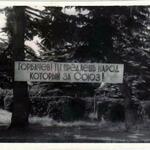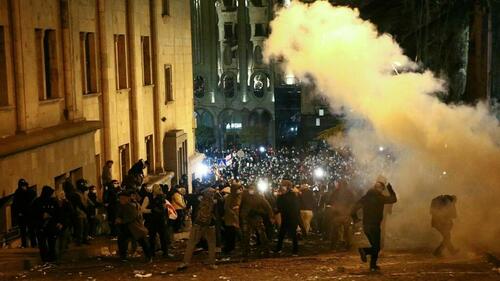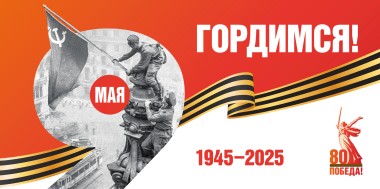Christmas 1991 is called in South Ossetia the bloody. January 6, 1991 Tskhinval was awakened by gunfire and barking dogs. The amazed inhabitants of Tskhinval saw in the streets unprecedented accumulation of armored vehicles, the Georgian militia gunmen in gray coats and German police dogs.
The submachine gunners were firing at passers-by, kidnapping people and subjecting them to torture (even their dogs behave themselves humanely, many of them have remained in the town, having found the new masters.) the first killed. Spontaneously were organized the self-defense units, barricades ... Thus started the events,euphemistically called "the Georgian-Ossetian conflict of 1991-1992."
But the concept of the "Georgian-Ossetian conflict" seems to be more extensive in chronological terms, covering a long historical period. In the post-Soviet period it includes the blockade of Tskhinval in 1989-1990, and the war in 2004 and 2008.
Georgian-Ossetian conflict from 1989 to 2008 claimed many lives. Were destroyed the whole communities. From mid-August 2008 by the active military, political and diplomatic actions of Russia, by its recognition of the independence of South Ossetia and the opening of the Russian military base, South Ossetians began to live in peace. Ossetians and Georgians are not killed any more. What was the reason of carefully maintaining of tense, unstable, extreme situation for a minimum of 19 years - from 1989 to 2008?
There are several factors, and among them is a prominent theory of hook, which was imposed on the Soviet and then – on the Russian (in Yeltsin`s time) leadership.
Although some authors put a phrase "theory of hook" in quotation marks, it had such a big impact on the important social and political processes, had such a colorful ideological mechanism, that it seems right to remove these quotes.
Much has been written about the theory of hook, providing for the forcible incorporation of South Ossetia into Georgia in exchange for Russian control over Georgia.
In this theory South Ossetia was assigned the role of bait that would be holding Georgia on the hook of Russia. Looking ahead, we should note: life has shown that this theory was false. The fraud was exposed and this theory died. Died, yes, but it lasted more than a century and during that time claimed the lives of thousands of mostly young people, absorbed their power, becoming a very powerful phantom.
Its last renaissance began 23 years ago, in 1989, when the Federal Centre did not take any measures (other than a purely cosmetic) for the protection of the people of South Ossetia from the invasion of the Georgian hordes of terrorists, who beat, killed and terrorized the Ossetian population on November 23, 1989, and then on January 6, 1991. Omission (or more precisely - the active connivance of Georgia) of the Centre in this regard was motivated by the backstage promises of Tbilisi to demonstrate loyalty to Moscow in the case of "giving up" the South Ossetians.
The subsequent economic blockade of South Ossetia and Abkhazia, after the introduction of peacekeeping forces also was the result of the same vague promises of Georgia. In exchange for the accession of Georgia to the amorphous CIS with unclear objectives and optional duties Georgia continued to get economic preferences and full political support of Russia in case of non-recognition of South Ossetia, including the decision to blockade of South Ossetia and Abkhazia, officially made by the heads of the CIS states.
I regret to note that, despite the continuous political, economic and military inferiority and danger for Russia, based on this the theory hook policy showed its vitality, although for this period it was subjected to the blows of the Georgian side, the last - and the deadly one - was a blow on the night of August 8, 2008.
Over the entire period of its life this theory created certain stereotypes, certain relationship in some political and parapolitical circles. And then we can talk about the paradox. Although in accordance with this theory a role of a stupid fish was being playedby Georgia, and the role of a clever fisherman – by Russia, in fact, it was Georgia keeping Russia on the hook, using it as a bait, various abstract and vague promises, and received from Russia for peanuts electricity, gas, and other very real and tangible benefits, including - but not least, a much more important (and bad for the image of Russia in international politics, as seems to be an unreliable partner which gives up its allies) - political support of the issues related to South Ossetia and Abkhazia.
Imagine Russia's actions, if from the very beginning the theory of hook had found an adequate understanding of the Russian political elite. Since the events of the last twenty years so far are in the memory of each of us, for clarity, we shall revive that time.
I. November 23, 1989 about 20 - 40 thousand (estimates vary) people by buses and cars came to Tskhinval with the announced purpose of "holding a meeting of friendship of the Georgian and the Ossetian peoples at the Theater Square in Tskhinval," though it was impossible for the all-knowing and all-powerful KGB of the USSR not to know the true intentions of the arrived crowd.
The same goal of coming of so numerous "delegation" was spread in the media of the Georgian Soviet Socialist Republic. This version (or excuse) does not hold water, because: a) a march on Tskhinval was preceded by threats against Ossetians in the Georgian informal publications and speeches by leaders of the national movement at the rallies in Georgian towns and villages;
b) The Theatre Square in Tskhinval is so small that it could not accommodate one fifth of the arrivals; с) the leaders of the arrived declined the proposal of the Ossetian side to let them holdinga meeting in Tskhinval after checking for the presence of firearms or cold weapon; d) in a few days after "standing on the fuel and energy sector," the arrivals blocked the roads connecting Tskhinval with the outside world, captured the passing Ossetians and severely dealt shortly with them. The Ossetians living in the villages of mixed Georgian-Ossetian population were expelled from their homes.
But Gorbachev did not take any measures to stabilize the situation in South Ossetia, though it was enough just a phone call from Moscow to Tbilisi, in the hope that Georgia would assess the tacit support of the Center and would notdramatize withdrawal from the Soviet Union. It can be regarded as the first manifestation of the policy of hook in the recent period: we will give you South Ossetia, and you will not secede from us.
What benefits it has brought? Not any. The course of Georgia to secede from the Soviet Union remained the same, and even intensified.
What harm it has brought? – The great one. Separatist forces in Georgia, seeking withdrawal of Georgia from the Soviet Union, as well as the forces working for the collapse of the Soviet Union, once again were convinced of the weakness of Moscow, and this fact gave them the signal to be more active. The governmental prestige was shaken greatly. The South Ossetians realized that for Moscow they had no value. Many people, who could afford financially, began to leave South Ossetia;the natural ally of Russia in the Caucasus began weakening.
And vice versa, if Gorbachev had rigidly suppressed Georgia's actions to destabilize the situation in South Ossetia by: a) adequate media coverage of the invasion of thousands of Georgian informal groups in South Ossetia, b) the law to be imposed in respect of the organizers of the march, c) taking additional set of measures to promote stability in South Ossetia, it could have been avoided: a) the death of the Soviet citizens, b) demonstration of the lack of any prospect of the attempts to protect the united federal state.
II. In January 1991, the night before Christmas, into Tskhinval from the Georgian territory were brought three thousand armed men, some of whom were employees of the Interior Ministry of the GSSR, and some – the released prisoners who at the football stadium of the city of Gori (70 kilometers from Tskhinval) had been dressed in police uniforms. They have occupied the center of Tskhinval and started the unmotivated arrests of the passers, opening fire on the unarmed citizens. Subsequently, the Georgian armed forces by brutal torture (incineration in stoves "torne", sawing people and burying alive, etc.) began to exterminate the Ossetian population, capture, loot and burn Ossetian villages ( some of them with the peaceful Ossetian population: Tliakana, Khelchua etc.). The state of emergency and a curfew was announced only in Tskhinval and in Dzhava (now - Dzausky) district, with majority of the Ossetians, and in Tskhinval, Znaur and Leningor districts of South Ossetia the state of emergency was not introduced, despite many months of requests from South Ossetia. This allowed the Georgian armed groups to commit the above steps, and the Soviet Interior Ministry troops, stationed in Tskhinval, were obliged only to come to the villages subjected to the Georgian attacks and bring the corps to Tskhinval. Attempts to bring alive people from the attacked villages in Tskhinval, in most cases, were not successful, as at the entrance to Tskhinval the Ossetian civilians were handed over to the Georgian armed groups by the Soviet Interior Ministry troops (thanks to comrade Pugo!) and after brutal tortures were put to extrajudicial death. The most famous example is the Eredvi tragedy in March 1991, when 12 Ossetian civilians were brought to the Georgian armed groups, subjected to tortures (such as burning of body parts of human beings, fractures of arms and legs) and then buried alive near the Georgian village of Eredvi.
During this period on the agenda was a question of preparation of a new Union treaty and Gorbachev tried to persuade the then President of Georgia Zviad Gamsakhurdia to its signing. The signing of a new Union treaty, nominally, was disrupted by the events of August 19-21, 1991, but in fact, Georgia had repeatedly said it would not sign it.
There were also talks of expanding the powers of the Union republics (though it could not be talks about the right of the union republics to commit mass murders of representatives of non-titular nations, apparently, they also meant it), and the scales tipped in favor of creating the conditions most-favored Georgia in its actions against South Ossetia.
Meanwhile, the adequate measures envisaged by the Soviet leadership would have avoided:
c) the rapid flow to North Ossetia over one hundred thousand (official) unsecured embittered refugees, d) increase of crime and the threat of instability in North Ossetia, which is part of Russia.
Measures of Russia to protect law in South Ossetia would have led to: a) increase of the authority of Moscow as a force capable of defending its allies; b) would have stopped the activity of separatist nationalist forces in the Union republics (for example, the same Gamsakhurdia one of the first supported the Emergency Committee, and even transformed the "National Guard" in a police department, deciding that the power had changedradically and permanently and that Moscow was now aimed at preserving the USSR).
Thus, Russia has not gotten any benefit from the theory of hook and the politics based on it, but only great damage.
However, with the coming to power in Georgia the Coalition of Ivanishvili "Georgian Dream" one can feel the attempts to resuscitate, revive the mortal theory of hook.
We have already passed through it. The question is: will the forces dare to express their aim to re-establish the structure that led to the bloodshed after the bitter experience?
Anatilical service of IA"RES"
Inal Pliev
In the picture - the slogan at the central square of Tskhinval, besieged and being shelled by the Georgian artillery, "Gorbachev, you betray the people who are for the Union!" The photo was taken by Vladimir Kornilov in the besieged Tskhinval in 1991.







